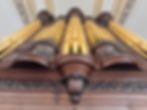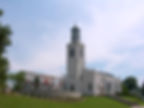St Mary Aldermanbury: Wren church, Churchill (and me)
- London On The Ground
- Jun 14
- 5 min read
A small City of London park with a rich history surprised me with a link to my past.

St Mary Aldermanbury Garden is one of those hidden nooks, combining history and beauty, in which the City of London specialises.
Walks available for booking
For a schedule of forthcoming London On The Ground guided walks and tours, please click here.
Located at the corner of Aldermanbury and Love Lane and very close to Guildhall, the garden takes its name from a church that once stood here. The medieval church of St Mary Aldermanbury is first mentioned in 1181 and appears on the Agas Map depicting London in c.1560.

The great London historian John Stow, writing in 1598, said that the church had a cloister, in which hung a “shank-bone of a man (as is said), very great, …twenty-eight inches and a half of assise”.
When the poet John Milton, writer of Paradise Lost, married his second wife Katherine Woodcocke in 1656, she was a member of the congregation at St Mary Aldermanbury. Some sources say that the wedding took place in the church (but others say they were married in St Margaret’s, Westminster).
The medieval church was destroyed by the Great Fire of London in 1666. It was rebuilt in the 1670s to a pared-down baroque design by Sir Christopher Wren. The final element, the cupola atop the tower, was added in 1679.

The notorious ‘hanging judge’ Lord Chief Justice Jeffreys was buried here in 1693, four years after his original burial at the Tower of London.
Alterations to Wren’s church were made in 1863 by Edmund Woodthorpe, an architect described by Elizabeth and Wayland Young in their 1954 book, Old London Churches, as the “prince of philistine restorers”.
According to the Youngs, Woodthorpe “despoiled it of its woodwork, put in a ‘Byzantine’ stone reredos and font, and filled the windows with the bloated Venetian tracery which was his speciality. … Later, a diagonally-striped organ in the wrong place completed the ruin”.
I am inclined to trust the aesthetic judgement of Elizabeth and Wayland Young on this. They were the parents of Emily Young, who has been described as Britain’s greatest living sculptor (see my post about her Five angel heads outside St Paul’s Cathedral, another City of London gem hiding in plain sight).
In fact, the Luftwaffe completed the ruin during the Blitz on 29 December 1940, when a fire bomb raid gutted St Mary Aldermanbury and devastated much of this part of the City. Fire destroyed the church’s roof, the windows and all the interior fittings, although its tower and walls remained standing.

More than 20 years after the end of World War II, when it was feared that the church would be destroyed, its future was assured in a very unexpected manner.
In 1965/66 its 7,000 blocks of Portland stone were dismantled and shipped across the North Atlantic to the United States.
They were reassembled at Westminster College, Fulton, Missouri, where the church was rebuilt and restored under architects Marshall Sisson and Patrick Horsebrugh and chief mason Eris Lytle.
Elizabeth and Wayland Young were no doubt heartened by the decision to model the interior as closely as possible on Wren’s original design.
The restored St Mary Aldermanbury in Fulton was re-consecrated on 7 May 1969.
It included a new organ by Noel Mander, a leading British organ builder, who had served as a wartime fire warden and was on duty in the City on the night of 29 December 1940 when St Mary Aldermanbury burned.
Mander based his organ design for the rebuilt St Mary on the organ he had made for the restored church of St Vedast on Foster Lane in the City of London.

Strangely, on a recent visit to St Vedast, I found some black and white photos of the rebuilt St Mary in the USA in a dusty frame leaning up against the back of Mander's organ.

The basement of the church in Missouri houses America’s National Churchill Museum, a crucial element of Westminster College’s vision for the project, inspired by Churchill’s ‘Sinews of Peace’ speech, given at the college on 5 March 1946.
In that speech, he first coined the terms “Iron Curtain” (describing the post-war division of Europe between east and west) and “special relationship” (describing the relationship between the UK and the US).
Czech-born sculptor Franta Belsky, who became a UK citizen, was commissioned to create a statue of Churchill outside the restored church in 1969.
A sculpture called Breakthrough, by Churchill’s granddaughter, sculptor Edwina Sandys, was installed outside the church in 1990. It was made from graffiti-covered sections of the Berlin Wall, a concrete manifestation of the Iron Curtain, which had been breached the year before after almost 38 years.

A third sculpture, entitled Iron Curtain and depicting Churchill giving his speech, by Don Wiegand, was unveiled in front of the Museum in 2011.
Back in the City of London, parts of Wren’s foundations of the church and interior columns can still be seen in St Mary Aldermanbury Garden.
The garden also displays a bust of William Shakespeare by Charles John Allen, commissioned in 1895 by Charles Clement Walker, a Victorian industrialist and philanthropist. It honours John Heminge and Henry Condell, Shakespeare’s friends and fellow actors, who first collected his plays for publication (see my post Shakespeare, the First Folio and the City of London).

This little park often features on my walking tours (it was part of the exam walk I did in order to qualify as a City Guide) and I have told the story of St Mary Aldermanbury many times over the past few years.
It was only recently that I discovered from a forgotten old family photo that I visited the church in Missouri as a teenager in the early 1980s, when my family lived in the US due to my father’s work.
We had a green Lincoln Continental and a camper trailer and visited more than 30 states in two years. I have no recollection of seeing St Mary Aldermanbury at that time, but the faded photo below clearly shows our car parked in front of it!

Walks available for booking
For a schedule of forthcoming London On The Ground guided walks and tours, please click here.




